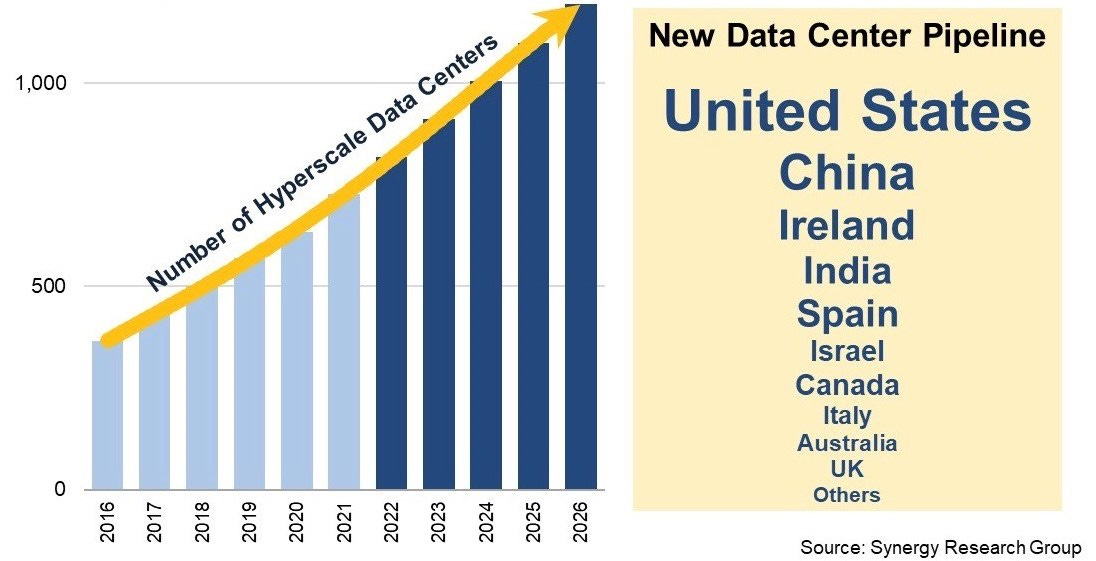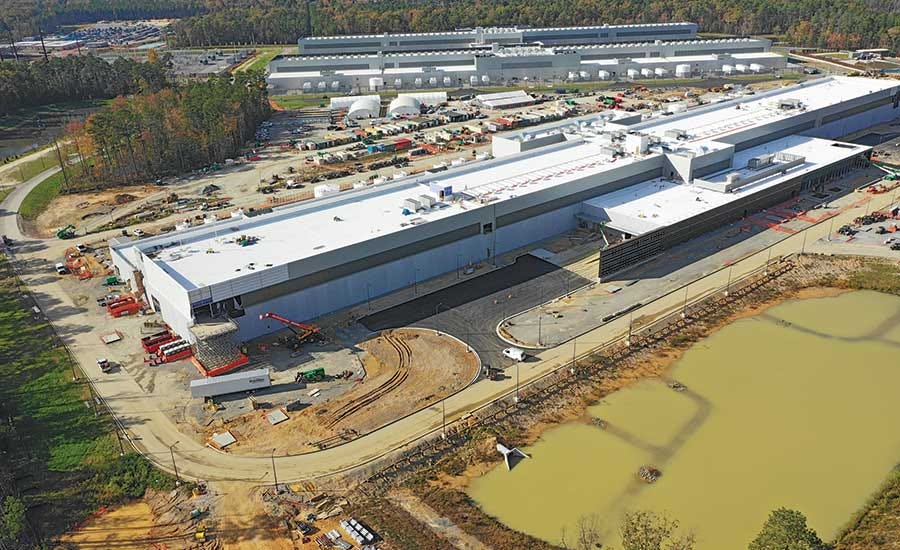Artificial Intelligence is Hot
Hyperscale data centers, AI overuse, another boiling point for climate change

Welcome my son
Welcome to the machine
Where have you been?
It's alright we know where you've been.Welcome my son
Welcome to the machine
What did you dream?
It's alright we told you what to dream.— Pink Floyd, from Wish You Were Here, 1975
Artificial intelligence rolled out last spring with much fanfare. Since then, I have experimented with ChatGPT and read numerous articles on the subject, organized into dozens of folders. As with all technology, AI comes with serious questions and potential for great good and great harm. Like all technology, that depends on the intent of the creators and users.
The Luddite Movement occurred in 19th-century England when textile workers opposed cost-saving machinery that replaced skilled labor, drove down wages and produced inferior goods. The term Luddite has come to be negatively associated with people who stand in the way of “progress,” the great mantra of humanity. The question isn’t whether we should make progress or not. The question is who defines progress and if it’s beneficial for the greater good or just for a few who sacrifice the rest of us for profit. Humanity has a consistent history of plunging into technology without careful study of its effects, or worse, knowing them and hiding the negative consequences. Certainly, we’re in the grip of climate change for that reason. Big Oil knew the truth. Those who roll technology out are nearly invariably motivated by profit above all else, regardless of the intentions of the inventors. And these days, as inventions stray further and further from anything the least bit essential, inventors need to be questioned as well.
AI is built on a toxic foundation
AI has been created by the open plunder of accumulated human knowledge, our intellectual property, by scraping the internet. This scraping is culturally biased and incomplete as well, but that’s a subject for a different article. Grandly publicized, this theft has been eagerly adopted by the corporate mob in its never-ending desire to read our minds and control our thoughts for profit. AI is knowledge, data and predictions, surveillance and job reductions, distractions, entertainment and human mimicry, in an increasingly inhuman world. Although impressive, it’s more alarming, and in no way intelligent, although it can appear cunningly so. There are potential upsides in the right hands, but used indiscriminately for profit and power, it’s another reality threatening tool that will make us more compliant to the corporate agenda destroying our inhabitable planet.
Artificial Intelligence is not intelligent
Current AI is created by training Large Language Models (LLMs) which are simply programs which when fed data become proficient at predicting the next word in a sentence. That’s it. This has been accomplished by massive numbers of computers scraping the internet, devouring all information available from corporate propaganda, to scientific publications, to culture. Scraping the internet is nothing new, bots have been crawling the web forever, but AI makes it far more efficient and capable of bypassing security measures as well. LLMs have most recently resulted in competitive chatbots such as ChatGPT, Microsoft Copilot, and Google Gemini (formerly Bard). Google promotes Gemini as a tool to “supercharge your creativity and productivity.” These chatbots have no intelligence, just predictive capabilities from training on data scraping. They merely recognize patterns. They “know,” for instance, the words ‘hotdogs and ___’ are likely to be followed by ‘mustard,’ not ‘donuts.’ They are parrots, but unlike parrots, have zero consciousness and no brains.
We have been using this form of AI Artificial Narrow Intelligence (ANI) for years. Autofill suggestions on internet searches are one example. Siri, Alexa, and Google Assistant, are examples as well, as are those annoying zombie bots on the phone when we would like to talk to a human being, an example of job elimination for profit.
Generative Artificial Intelligence
Currently, in the news is “generative” AI. While it’s impressive, hold your applause. Generative AI is still just ANI, an unaware, predictive response model built on LLMs. With simple text prompts, generative AI can produce photo realistic images or images in the style of the artist of your choice. Rembrandt or Warhol can be reduced to your whim. You can develop an ad jingle in the lyrical style of Mozart or with the gritty rawness of Big Mama Thornton. The brilliance of human genius can be reduced to a few strokes on your keyboard, eliminating the need for collaboration, or discovering something or someone new.

Generative AI such as DALL-E can create images of people that never lived and events that never happened, a questionable development in an increasingly divided world with a tenuous grasp on reality. The prosaic tools we are familiar with — radio, television and social media — have already been wielded to create profound division. In addition to job loss, which the Luddites rebelled against, generative AI is a tool that is already being used to create massive deception. The pushers of this technology are rushing to generate moving images as well, video. It’s only a matter of time and computer power.
As dangerous and dumb as ANI is, it’s not the ultimate goal of the technology, it’s merely what can be accomplished now. What is desired is far more disturbing.
Artificial General Intelligence (AGI), or strong AI, would be closer to the level of human intellect, as supposedly AGI systems would be able to reason and think like humans.
Artificial Super Intelligence (ASI) would be a system where machine intelligence surpasses and outperforms yours and mine. I’m sure that’s not a problem.
AGI and ASI are hypotheticals at this point, although you and I both know in labs around the world teams of otherwise intelligent people are competing to make them reality. The energy requirements of AGI and ASI are unimaginable and would require an unprecedented build out of server farms, strain or break energy grids and require astonishing amounts of water for cooling in an increasingly drought stricken world.

Even simple-minded ANI’s energy requirements will grow exponentially as it’s applied unnecessarily and used for vacuous entertainment and commercial purposes rather than solely for solving tiny little problems like climate change, the end of oil and The Sixth Extinction. Just a simple search engine request to see what Taylor Swift is wearing today requires four or five times the energy in AI assisted search engines. Google searches alone amount to billions per day and trillions per year. People playing with DALL-E for amusement is simply unnecessary, and those using ANI to replace people are stupidly in danger of replacing themselves.
Energy demands and natural resource use of AI
Energy use of current and future AI is the subject of debate. Developers are less than forthcoming with the figures. How surprising.
From an interview in Scientific American of Alex de Vries, a data scientist at the central bank of the Netherlands and a Ph.D. candidate at Vrije University Amsterdam, where he studies the energy costs of emerging technologies. Answering the question, “Why do you think it’s important to examine the energy consumption of artificial intelligence?,” de Vries said:
“Because AI is energy-intensive. I put one example of this in my research article: I highlighted that if you were to fully turn Google’s search engine into something like ChatGPT, and everyone used it that way — so you would have nine billion chatbot interactions instead of nine billion regular searches per day — then the energy use of Google would spike. Google would need as much power as Ireland just to run its search engine... if you’re going to be using generative AI in applications [such as a search engine], that has the potential to make every online interaction much more resource-heavy.”
From an on op-ed on The Guardian:
“AI requires staggering amounts of computing power. And since computers require electricity, and the necessary GPUs (graphics processing units) run very hot (and therefore need cooling), the technology consumes electricity at a colossal rate. Which, in turn, means CO2 emissions on a large scale — about which the industry is extraordinarily coy, while simultaneously boasting about using offsets and other wheezes to mime carbon neutrality.”
According to the International Energy Agency (IEA) current energy use of data centers stands at just 1 to 1.5 percent of global electricity use. Numerous sectors use far more. However, AI electricity use stands poised to change that dramatically.
Some claim AI will be a force for good, speeding medical research, for instance. I agree. Some say it will be a powerful tool for advancing sustainability solutions on our feverish planet by improving climate change modeling. There is that potential, but if it’s applied for frivolous entertainment and maximizing consumer demand, its energy needs will exceed its benefit. Unregulated energy demands of AI are a new and undeniable hazard. If you don’t believe me, believe OpenAI’s CEO Sam Altman.
In February, Altman warned of what researchers have been saying for years, that the next wave of generative AI systems will consume vastly more power than expected, and that energy systems will struggle to cope. At the World Economic Forum’s annual meeting in Davos, Switzerland, Altman said, “There’s no way to get there without a breakthrough.” Sam is banking on nuclear fusion with investment in Helion Energy in Everett, Washington.
Helion’s most optimistic estimate is that its fusion efforts will it produce enough energy to power just 40,000 average US households by 2029. ChatGPT, the created by Altman’s OpenAI, is estimated to already be consuming the energy of 33,000 homes, and fission is the ultimate perpetual dangling carrot. As usual, we have leaped before we looked.
Current trends in AI capacity and adoption are projecting American multinational corporation NVIDIA to ship 1.5 million AI server units per year by 2027. A terawatt-hour (TWh) is a unit of energy that represents one trillion watts of power used for one hour. 1.5 million servers, running at full capacity, would consume the energy equivalent to what many small countries use in a year, at least 85.4 terawatt-hours.
Why will AI energy demands become so high?
AI energy demand can be thought of in three stages, feeding LLMs massive amounts of data (training), release and application to businesses and the public, and ongoing training to keep AI current. Those demands are affected by the efficiency of the hardware and quality of the coding (poor coding consumes more energy). Frivolous use for public entertainment and increasing corporate bottom lines should be off the table as our planet heats up.
According to Statista, there are nearly 10,600 data centers worldwide, ranging in size from small office buildings to the hyperscale facilities — mostly owned by Amazon, Microsoft and Google — that power the cloud and span football fields.
In 2019, there were over 500 hyperscale facilities, in 2021, 728. Taking on average just two years to build, the global total is set to hit 1,200 by 2026.

Hyperscale facility growth by 2026
Proponents argue chip technology is becoming more efficient and that many server farms use renewable energy. This is true.
It is also true that Big Tech companies such as Amazon, Google and Microsoft have pioneered corporate Power Purchase Agreements (PPAs) to power their data centers with renewable energy. PPAs are commitments by companies to purchase renewable energy in powering their operations.
Amazon makes claims here, Google here, and Microsoft here. According to the IEA, in 2020, the big five tech companies purchased 7.2 gigawatts (7.2 billion watts) of renewable capacity, about 30 percent of all corporate renewable PPAs, or around 3.5 percent of all global renewable capacity additions. Also, according to the IEA, US big tech has made commitments to purchase the same quantity of electricity from renewable sources as their annual consumption standard. While positive, it’s likely many of these projects would have gone forward regardless and this commitment is used as cover to camouflage the true impact of unlimited AI. For instance, where renewable energy doesn’t exist, the life of coal-fired plants is prolonged.
The builders and users of data centers claim climate impact sustainability. However, sheer demand is sheer demand. If Sam Altman is right, and I believe he is, energy demands for AI are destined to explode, outstripping what can be supplied by renewables AND fossil fuels, particularly with the godlike pursuit of AGI and ASI, which would require thousands of new hyperscale data centers, not merely hundreds, and trillions of gallons of water. One hundred percent more data usage with even a seventy percent increase in efficiency still adds to actual CO2 release, as well as water and mineral demand. It’s not just that data centers use energy, it’s building them and manufacturing computers, quickly outdated and discarded. It’s greenhouse gas emissions from making concrete and steel, and toxic PVC pipe for cooling systems to build server complexes that cover tens of thousands of acres. It’s environmental destruction while extinction rates runaway. All these steps require heavy diesel burning equipment for mining, transport of raw materials, manufacturing finished products and excavation and building. We can’t consider the efficiency of data centers apart from the impact of creating them. We can’t afford runaway profit-driven implementation so that I can make pictures of my cat chucking hairballs in the style of Leonardo da Vinci for my amusement.
Implemented judiciously, AI in the right hands could be used as a powerful tool to reduce the now inevitable impact of the climate crisis. Used indiscriminately, this technology will hasten our ride off the cliff.



This article was well worth the wait.
A simple example of job loss that has already occurred is in the manufacturing industries with CAD/CAM . In the 60s the design process was an engineer did a design on paper (with a slide rule- remember those?) A rough sketch then went to a draftsman who fleshed out the drawing into a blueprint for the manufacturing department. That drawing went into the hands of a skilled worker who created the part. All were high paying jobs requiring various levels of higher education.
With the advent of cad/cam the draftsman job has been completely eliminated, the skilled worker has been reduced to someone pushing a button to create the part and the part is created by a CNC machine in 1/10 or less the time. Engineers, draftsman and skilled labor jobs were all eliminated by computer technology.
This is the simplified version and the job loss has been far more extensive. In the 60s all of this "futuristic" technology was going to lead to a 20 hour work week and an abundance for all with an unimaginable high standard of living. Promoted in school I might add. Now 40 years later what do we have? Low paying poverty wage jobs. A largely unskilled uneducated workforce working 2 jobs living paycheck to paycheck. An increasing population of homeless. A society which is controlled and manipulated by the government, corporations and financial institutions. Mass production of useless junk with built in planned obsolescence resulting in ecocide and overuse of resources as well as the establishment of a two class system, the wealthy and the poor.
Currently the main function of AI is for control of the masses by surviallance programs, psychological manipulation by the media and government and the effectiveness of the manipulation. LLMs are predictive algorithms which can be used to establish the outcome of government policies by monitoring people's reactions in realtime by email, voice comments and public reaction and adjusted accordingly for the desired result. It's all part of a psychological Operations plan developed by the air force back in the 70s and enhanced by the development of the internet and computer technology.
PsychologicalOperationsGoldstein.pdf
The greatest inevitable danger of AI is going to be the reduction of intelligence and creativity in humans. Not to mention the job losses in more skilled jobs and increased poverty. Robot development will eliminate the more mundane tasks such as stocking shelves and maintenance very soon. So the question is when most jobs for humans are eliminated who will buy the products being produced?
I'd be interested to see what AI would propose for solutions to homelessness or ecocide/climate change. Currently it's being used by Israel for targeting sites in Gaza for the military. Killing in a word. More people have been killed with it than lives saved. I think we can assume that it's being used in the US for monitoring and targeting dissidents here. It's how you get the enhanced security check at the airport with the SSS on your ticket.
Stephen Hawking believed that AI was the greatest danger to humanity more so than nuclear weapons.
So where does this all end?
Thanks for a great well researched article. I guess we can thank AI at least in part.
What a fascinating and eye-opening read. Thank you, staggering outlook on one of the world’s biggest recent developments. Especially your reporting of the energy it takes to use A(N)I.